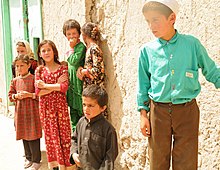淺膚色

淺膚色是指一種顏色較白的膚色,擁有淺膚色的人黑色素較少,而且一般生活在紫外线較弱的地區,他們一般會被稱作白人。 [1][2][3]欧洲和东北亚的原住民的膚色較淺。 [4][5][6][7][3][8] 浅肤色人群起初都几乎居住在远离赤道的高纬度地区,這些地方的太阳光强度较低。 [9]
1960年代,生物化学家W. Farnsworth Loomis發現,生活在高緯度的淺膚色人群能吸收更多的维生素D。浅色(菲茨派屈克度量 II 型)皮肤的人产生前维生素D3的速度比深色皮肤( V 型)的人要快5-10 倍。而一定量的维生素D有助于人體吸收更多的钙。 [10][11][12][13][14]不過深肤色人群可以通過飲食來攝取维生素D,例如 [15][16]驯鹿的肉、内脏和脂肪都含有大量维生素D。 [17]
黑色素可以防止葉酸耗盡出現葉酸缺乏症以及DNA受损。[3][18][19][20] 所以淺膚色人群如果居住在太阳光強度較高的赤道附近時,他們體內叶酸耗竭的风险會增加。如果叶酸耗尽的話,他们會面临更高的DNA损伤、先天性障碍和罹患多种癌症(尤其是皮膚癌的风险。 [3]而且膚色特別淺的人容易出現雀斑。[21][3]肤色非常浅的人( I 型和II 型)在黑色素细胞中产生的黑色素非常少,并且在紫外线辐射的幾乎很難產生黑色素,[22]所以這類人也容易晒伤,並且皮肤下的结缔组织和脱氧核糖核酸會被破壞,过早衰老和罹患皮膚癌。[23][24] III-IV型膚色的人在受到紫外線輻射後就能产生黑色素。[25][26]
隨著新航路開闢後各大洲人员流动日益頻繁,当今世界各地都有浅肤色人群。 [3][27]



参考文献[编辑]
- ^ light-skinned (页面存档备份,存于互联网档案馆) Princeton University
- ^ Light-skinned. thefreedictionary.com. [24 January 2017]. (原始内容存档于2020-04-23).
- ^ 3.0 3.1 3.2 3.3 3.4 3.5 Muehlenbein, Michael. Human Evolutionary Biology
 . Cambridge University Press. 2010: 192–213.
. Cambridge University Press. 2010: 192–213.
- ^ Relethford, John. Fundamentals of Biological Anthropology. Mayfield Publishing Company. 1997: 270 [2023-03-06]. ISBN 978-1559346672. (原始内容存档于2020-05-11).
- ^ Oxford Dictionaries. April 2010. Oxford University Press. "belonging to or denoting a human group having light-coloured skin" "white" (accessed 6 August 2012).
- ^ Dictionary.com: white (页面存档备份,存于互联网档案馆) 3.a "marked by slight pigmentation of the skin"
- ^ Global Census. American Anthropological Association. [10 December 2012]. (原始内容存档于14 September 2018).
- ^ Kirchweger, Gina. The Biology of Skin Color: Black and White. Evolution Library. PBS. [22 September 2018]. (原始内容存档于2013-02-16).
- ^ Modern human variation: overview. (原始内容存档于5 November 2012).
- ^ Clements, T. L.; Adams, J. S.; Henderson, S. L.; Holick, M. F.; et al. Increased skin pigment reduces the capacity of skin to synthesize vitamin D (PDF). Lancet. 1982, 1 (8263): 74–76 [2023-03-06]. PMID 6119494. S2CID 41818974. doi:10.1016/S0140-6736(82)90214-8. (原始内容存档 (PDF)于2020-04-29).
- ^ Jablonski, N. G.; Chaplin, G. The evolution of human skin coloration. Journal of Human Evolution. 2000, 39 (1): 57–106. PMID 10896812. doi:10.1006/jhev.2000.0403.
- ^ Webb, A. R. Who, what, where, and when: influences on cutaneous vitamin D synthesis. Progress in Biophysics and Molecular Biology. 2006, 92 (1): 17–25. PMID 16766240. doi:10.1016/j.pbiomolbio.2006.02.004
 .
.
- ^ Armas, L. A.; Dowell, S.; Akhter, M.; Duthuluru, S.; Huerter, C.; Hollis, B. W.; Lund, R.; Heaney, R. P.; et al. Ultraviolet-B radiation increases serum 25-hydroxyvitamin D levels: The effect of UVB dose and skin color. Journal of the American Academy of Dermatology. 2007, 57 (4): 588–593. PMID 17637484. doi:10.1016/j.jaad.2007.03.004.
- ^ Chen, T. C.; et al. Factors that influence the cutaneous synthesis and dietary sources of vitamin D. Archives of Biochemistry and Biophysics. 2007, 460 (2): 213–217. PMC 2698590
 . PMID 17254541. doi:10.1016/j.abb.2006.12.017.
. PMID 17254541. doi:10.1016/j.abb.2006.12.017.
- ^ Bjorn, L. O.; Wang, T; et al. Vitamin D in an ecological context. International Journal of Circumpolar Health. 2000, 59 (1): 26–32. PMID 10850004.
- ^ Van deer Meer; Boeke, A. J.; Lips, P.; Grootjans-Geerts, I.; Wuister, J. D.; Devillé, W. L.; Wielders, J. P.; Bouter, L. M.; Middelkoop, B. J.; et al. Fatty fish and supplement are the greatest modifiable contributors to the serum 25-hydroxyvitamin D concentration in a multiethnic population. Clinical Endocrinology. 2007, 68 (3): 466–472 [2023-03-06]. PMID 17941903. S2CID 15728496. doi:10.1111/j.1365-2265.2007.03066.x. hdl:1871/22170. (原始内容存档于2020-05-01).
- ^ Jablonski, Nina. Living Color. Berkeley, Los Angeles, London: University of California Press. 2012. ISBN 978-0-520-25153-3.
- ^ Vieth, Reinhold. Agarwal, Sabrina C; Stout, Sam D , 编. Effects of vitamin D on bone and natural selection of skin color: how much vitamin D nutrition are we talking about?. New York: Kluwer Academic/Plenum Press. 2003: 139–154. ISBN 978-1-4613-4708-8. doi:10.1007/978-1-4419-8891-1.
- ^ Hatchcock, J. N.; Shao, A.; Vieth, R.; Heaney, R.; et al. Risk assessment for vitamin D. American Journal of Clinical Nutrition. 2007, 72 (1): 451–462. PMID 17209171. doi:10.1093/ajcn/85.1.6
 .
.
- ^ Kimball, Samantha; Fuleihan, Ghada El-Hajj; Vieth, R; et al. Vitamin D: a growing perspective. Critical Reviews in Clinical Laboratory Sciences. 2008, 45 (4): 339–414. PMID 18568854. S2CID 57808076. doi:10.1080/10408360802165295.
- ^ Rhodes, A. R.; et al. Sun-induced freckles in children and young adults: a correlation of clinical and histopathologic features. Cancer (journal). 1991, 67 (7): 1990–2001. PMID 2004316. doi:10.1002/1097-0142(19910401)67:7<1990::aid-cncr2820670728>3.0.co;2-p
 .
.
- ^ Fitzpatrick, T. B.; Ortonne, J. P. Normal skin color and general considerations of pigmentary disorders. In Fitzpatrick's Dermatology in General Medicine. 2003, 6: 819–825.
- ^ Cleaver, J. E.; Crowely, E. UV damage, DNA repair and skin carcinogenesis. Frontiers in Bioscience. 2002, 7 (1–3): 1024–1043. PMID 11897551. doi:10.2741/cleaver
 .
.
- ^ Matsumura, Yasuhiro; Ananthawamy, Honnavara N. Toxic effects of ultraviolet radiation in the skin. Toxicology and Applied Pharmacology. 2004, 195 (3): 298–308. PMID 15020192. doi:10.1016/j.taap.2003.08.019.
- ^ Tadokoro, T.; et al. Mechanisms of skin tanning in different racial/ethnic groups in response to ultraviolet radiation. Journal of Investigative Dermatology. 2005, 124 (6): 1326–1332. PMID 15955111. doi:10.1111/j.0022-202X.2005.23760.x
 .
.
- ^ Nielsen, K.P.; et al. The importance of the depth distribution of melanin in skin for DNA protection and other photobiological processes. Journal of Photochemistry and Photobiology B: Biology. 2006a, 82 (3): 194–198. PMID 16388960. doi:10.1016/j.jphotobiol.2005.11.008.
- ^ O'Neil, Dennis. Skin Color Adaptation. Human Biological Adaptability: Skin Color as an Adaptation. Palomar. [10 December 2012]. (原始内容存档于18 December 2012).
